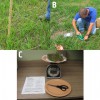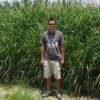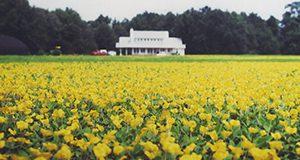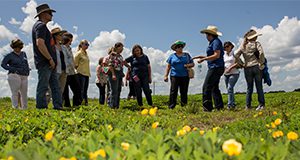Because of its adaptability to Florida's environmental conditions and ability to produce viable seeds, pintoi peanut represents an interesting forage alternative for cow-calf producers in the state. This 5-page document provides current information on pintoi peanut for forage and livestock producers in Florida. Written by Joao M. D. Sanchez, Joao Vendramini, Maria L. Silveira, Jose C. B. Dubeux Jr., Lynn E. Sollenberger, and Philipe Moriel, and published by the UF/IFAS Agronomy Department, November 2020.
https://edis.ifas.ufl.edu/ag445
Tag: Lynn E. Sollenberger
Ecosystem Services Provided by Grass-Legume Pastures
Grasslands produce far more than beef and milk. They provide ecosystem services that benefit people and the environment. This new 3-page document discusses how integrating forage legumes into grasslands enhances their capacity to provide ecosystem services, such as C sequestration, habitat for wildlife and pollinators, water catchment and purification, and nutrient cycling. Written by Jose Dubeux, Jr., Lynn Sollenberger, Mark Mauldin, and Liza Garcia, and published by the UF/IFAS Agronomy Department, October 2018.
http://edis.ifas.ufl.edu/ag423
Strip-Planting Rhizoma Peanut into Grazing Systems
Nitrogen (N) is one of the major off-farm inputs in livestock systems, either in the form of N fertilizer or purchased feed. Fortunately, you can reduce those expenses by growing your own nitrogen using forage legumes. Rhizoma perennial peanut (RPP) is a legume adapted to the Florida environment that grows well in mixtures with bahiagrass. This 4-page fact sheet discusses varieties, establishment, weed management, grazing management, and the cost-share program. Written by Jose Dubeux, Lynn Sollenberger, Joao Vendramini, Marcelo Wallau, Ann Blount, Liza Garcia-Jimenez, Erick Santos, and David Jaramillo, and published by the UF/IFAS Agronomy Department, July 2018.
http://edis.ifas.ufl.edu/ag421
Estimando la Cantidad de Forraje en Campos de Heno y Potreros
 El forraje sirve como fuente primaria de nutrientes para la industria ganadera en Florida. El uso eficiente de esta fuente nutricional es crítico para la supervivencia de los agricultores y rancheros de dicho estado. El estimar la cantidad de forraje en potreros puede proveer información útil a la hora de tomar decisiones acerca del manejo de nuestros recursos. Debe de haber suficiente material en el predio para justificar el costo de utilizar el equipo para cosechar (por ejemplo, precio de compra del equipo, renta, costo del combustible a invertirse, y el costo de la mano de obra). Sin esta información, el predio debe ser sometido a pastoreo. Esta publicación contiene las instrucciones para la implementación de un método simple que nos permite determinar la cantidad aproximada de forraje en campos de heno y potreros.This 2-page fact sheet was written by T. Wilson, C. Sanders, J. Breman, y L. Sollenberger. Traducido por J. Bosques, and published by the UF Department of Agronomy, January 2014.
El forraje sirve como fuente primaria de nutrientes para la industria ganadera en Florida. El uso eficiente de esta fuente nutricional es crítico para la supervivencia de los agricultores y rancheros de dicho estado. El estimar la cantidad de forraje en potreros puede proveer información útil a la hora de tomar decisiones acerca del manejo de nuestros recursos. Debe de haber suficiente material en el predio para justificar el costo de utilizar el equipo para cosechar (por ejemplo, precio de compra del equipo, renta, costo del combustible a invertirse, y el costo de la mano de obra). Sin esta información, el predio debe ser sometido a pastoreo. Esta publicación contiene las instrucciones para la implementación de un método simple que nos permite determinar la cantidad aproximada de forraje en campos de heno y potreros.This 2-page fact sheet was written by T. Wilson, C. Sanders, J. Breman, y L. Sollenberger. Traducido por J. Bosques, and published by the UF Department of Agronomy, January 2014.
http://edis.ifas.ufl.edu/ag379
Production of Miscanthus x giganteus for Biofuel (SSAGR292/AG297)
 The bioenergy industry has primarily used Miscanthus for combustion in power plants. It has desirable properties of low water and ash contents following a dry-down period before harvest. Current research is focused on its potential as a biomass crop for direct combustion and for lignocellulosic conversion to ethanol and other biofuels. This 3-page fact sheet was written by John Erickson, Curtis Rainbolt, Yoana Newman, Lynn Sollenberger, and Zane Helsel, and published by the UF Department of Agronomy, September 2012.
The bioenergy industry has primarily used Miscanthus for combustion in power plants. It has desirable properties of low water and ash contents following a dry-down period before harvest. Current research is focused on its potential as a biomass crop for direct combustion and for lignocellulosic conversion to ethanol and other biofuels. This 3-page fact sheet was written by John Erickson, Curtis Rainbolt, Yoana Newman, Lynn Sollenberger, and Zane Helsel, and published by the UF Department of Agronomy, September 2012.
http://edis.ifas.ufl.edu/ag297
Estimating Amount of Forage in Hay Fields and Pastures (SSAGR360/AG369)
 Forage serves as the primary source of nutrients for livestock in Florida, and efficient use of forage is critical to the livelihood of Florida farmers and ranchers. Estimating the amount of forage in a pasture can provide useful information when making management decisions. There must be enough material in the field to justify the cost of using harvesting equipment; otherwise, the area should be grazed. This 2-page fact sheet contains instructions for a simple method to determine the approximate amount of forage in hay fields and pastures. Written by T. Wilson, C. Sanders, J. Breman, and L. Sollenberger, and published by the UF Department of Agronomy, March 2012.
Forage serves as the primary source of nutrients for livestock in Florida, and efficient use of forage is critical to the livelihood of Florida farmers and ranchers. Estimating the amount of forage in a pasture can provide useful information when making management decisions. There must be enough material in the field to justify the cost of using harvesting equipment; otherwise, the area should be grazed. This 2-page fact sheet contains instructions for a simple method to determine the approximate amount of forage in hay fields and pastures. Written by T. Wilson, C. Sanders, J. Breman, and L. Sollenberger, and published by the UF Department of Agronomy, March 2012.
http://edis.ifas.ufl.edu/ag369
Mulato II (Brachiaria sp.) (SSAGR303/AG310)
Mulato II is a semi-erect perennial apomictic grass that can grow up to 9 ft tall. Brachiariagrasses, including Mulato II, are tropical warm-season forages native to Africa and are the most widely grown forages in tropical South America. This 4-page fact sheet describes teh morphology, region of adaptation and growing season in Florida, recommended production practices, and the results of research into the performance of heifers grazing Mulato. Written by J. Vendramini, B. Sellers, L.E. Sollenberger, and M. Silveira, and published by the UF Department of Agronomy, March 2011.
http://edis.ifas.ufl.edu/ag310
SSAGR94/AG162 General Guidelines for Managing Pastures for Dairy Cows
Revised! SS-AGR-94, a 4-page illustrated fact sheet by L. E. Sollenberger, Y.C. Newman, and J.M.B. Vendramini, is part of the Florida Forage Handbook. It answers dairy producers’ questions about managing pasture as a major source of nutrients for milking cows — soil testing and pasture fertilization, choice of forage species, and grazing strategies. Published by the UF Department of Agronomy, June 2009.
http://edis.ifas.ufl.edu/AG162
SSAGR93/AG161 Factors Affecting Forage Quality
Revised! SS-AGR-93, a 5-page illustrated fact sheet by A. T. Adesogan, L. E. Sollenberger, Y.C. Newman, and J.M.B. Vendramini, discusses forage quality and factors affecting intake and nutritive value. Includes references. Published by the UF Department of Agronomy, June 2009.
http://edis.ifas.ufl.edu/AG161
SS AGR 303/AG310 Mulato (Brachiaria sp.)
SS-AGR-303, a 4-page fact sheet by J. Vendramini, U. Inyang, B. Sellers, L.E. Sollenberger and M. Silveira, describes the this apomictic hybrid of brachiaragrass with good growing potential for Florida pastures. Includes references. Published by the UF Department of Agronomy, May 2008.
http://edis.ifas.ufl.edu/AG310


